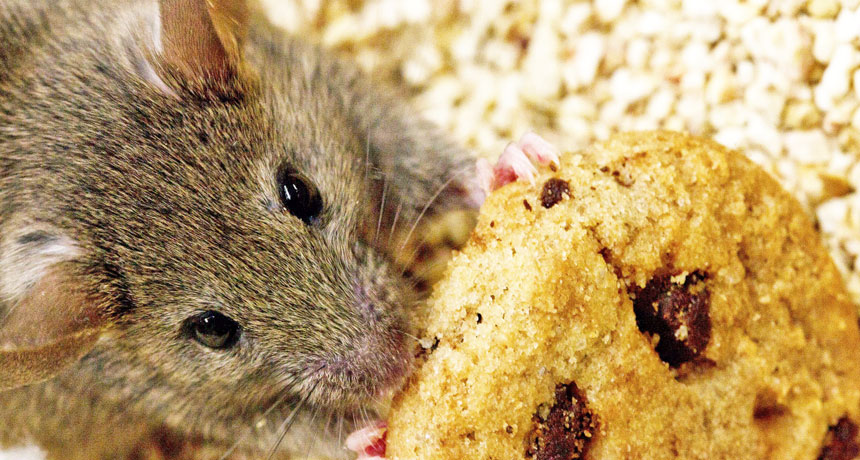Obscure brain region linked to feeding frenzy in mice
Optogenetics reveals a possible role in binge eating for nerve cells in zona incerta

CHOW TIME When scientists used light to stimulate select nerve cells in a region of the brain called the zona incerta, mice began eating voraciously. The results suggest that the little-studied brain region may have a role in eating behavior.
Anthony van den Pol
Nerve cells in a poorly understood part of the brain have the power to prompt voracious eating in already well-fed mice.
Two to three seconds after blue light activated cells in the zona incerta, a patch of neurons just underneath the thalamus and above the hypothalamus, mice dropped everything and began shoveling food into their mouths. This dramatic response, described May 26 in Science, suggests a role in eating behavior for a part of the brain that hasn’t received much scrutiny.
Scientists have previously proposed a range of jobs for the zona incerta, linking it to attention, movement and even posture. The new study suggests another job — controlling eating behavior, perhaps even in humans. “Being able to include the zona incerta in models of feeding is going to help us understand it better,” says study coauthor Anthony van den Pol, a neuroscientist at Yale University.
The new results may also help explain why a small number of Parkinson’s disease patients develop binge-eating behavior when electrodes are implanted in their brains to ease their symptoms. Those electrodes may be stimulating zona incerta nerve cells, van den Pol suspects.
He and his collaborator Xiaobing Zhang, also of Yale, studied the mice with a technique called optogenetics. Mice were engineered so that some nerve cells in the zona incerta fired off signals when hit with blue light. When the light activated these cells, the mice immediately found the food and began eating, the researchers reported. “It’s really quick,” van den Pol says.
After just 10 minutes of stimulation, mice had consumed 35 percent of what they would normally eat in 24 hours. Mice without the stimulation ate just 4 percent of their daily intake in the same 10-minute period.
Regular sessions of stimulation — five minutes every three hours — resulted in weight gain, the researchers found. After two weeks of this regimen, mice had ballooned from about 24 grams to about 38 grams on average. When the stimulation was stopped, the mice began to shed the excess grams.
These zona incerta nerve cells send lots of signals to nerve cells in a part of the thalamus called the PVT, a region thought to be involved with monitoring energy levels. Other experiments described in the study suggest that changing the activity of PVT nerve cells directly also influences eating behavior, results that implicate the zona incerta–PVT connection in the powerful signal to eat.
But neuroscientist László Acsády of the Institute of Experimental Medicine in Budapest encourages caution. “The zona incerta is not only little-studied but ill-defined,” he says, and it includes nerve cells with widely different jobs. That complexity means that it’s hard to tease out exactly which cells are behind the behavior.
“The eating effect evoked by activating these cells is probably real and interesting,” Acsády says. But it’s possible that mice’s aggressive eating is driven by other nearby cells, particularly those that send signals to the hypothalamus, a brain area known to be involved in appetite, he says.







